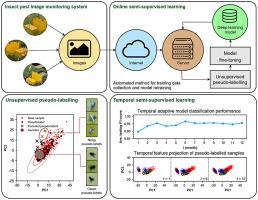Biosystems Engineering ( IF 5.1 ) Pub Date : 2021-06-05 , DOI: 10.1016/j.biosystemseng.2021.05.006 Dan Jeric Arcega Rustia , Chen-Yi Lu , Jun-Jee Chao , Ya-Fang Wu , Jui-Yung Chung , Ju-Chun Hsu , Ta-Te Lin

|
The unavailability and variability of training samples are the two essential concerns in the training of deep neural network models for image classification. For automated image monitoring systems, these problems are difficult when training a model through supervised learning methods because of the time and effort required. This paper proposes an adaptive solution to this problem by applying online semi-supervised learning to an automated insect pest monitoring system. The method used includes unsupervised pseudo-labelling of insect images and the training of semi-supervised classifier models for insect image recognition. The pseudo-labelling algorithm includes three major components: image labelling, label reconfirmation, and sample cleaning. Experiments were conducted on two unlabelled 1-year insect image datasets to evaluate the efficacy of the proposed method. It was found that the pseudo-labelling algorithm could achieve accuracy up to 0.963, hence enabling automated training data collection. The temporal improvement of the insect recognition performance by including new training data to retrain the classifier model was comparable in performance to the supervised learning approach as evaluated by cluster density, silhouette score, and F1-score. The proposed method was also able to automatically collect quality samples and train models regardless of the complexity of the images, making it a good alternative to replace laborious supervised learning. The proposed method can prevent contamination of a training dataset when images from new locations are collected. The presented techniques may also be used in other continuous learning applications that require automated training data collection and online model update.
中文翻译:

应用于自动化害虫监测系统的在线半监督学习
训练样本的不可用性和可变性是训练用于图像分类的深度神经网络模型的两个基本问题。对于自动图像监控系统,由于需要时间和精力,在通过监督学习方法训练模型时,这些问题很困难。本文通过将在线半监督学习应用于自动化害虫监测系统,提出了针对该问题的自适应解决方案。使用的方法包括昆虫图像的无监督伪标记和用于昆虫图像识别的半监督分类器模型的训练。伪标记算法包括三个主要部分:图像标记、标签重新确认和样本清洗。在两个未标记的 1 年昆虫图像数据集上进行了实验,以评估所提出方法的有效性。发现伪标记算法可以达到高达 0.963 的准确度,从而实现自动训练数据收集。通过包含新的训练数据来重新训练分类器模型,昆虫识别性能的时间改进在性能上与通过聚类密度、轮廓分数和F 1分。无论图像的复杂程度如何,所提出的方法还能够自动收集质量样本并训练模型,使其成为替代费力的监督学习的良好替代方案。当收集来自新位置的图像时,所提出的方法可以防止训练数据集受到污染。所提出的技术还可用于需要自动训练数据收集和在线模型更新的其他持续学习应用程序。


























 京公网安备 11010802027423号
京公网安备 11010802027423号